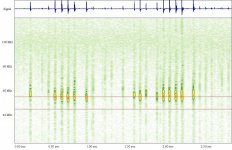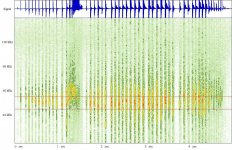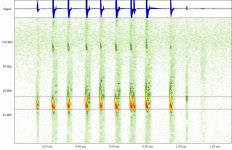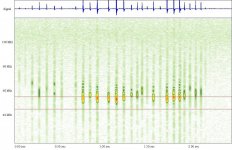Hi
You may find the following of some use:
http://www.echoesecology.co.uk/documents/AnIntroductionToTheBatsofScotlandEdition1Dec2006_002.pdf
http://www.somersetbirder.co.uk/sonograms.htm
There is a booklet with sonograms of most UK bats:
RUSS, J. 1999. The Bats of Britain and Ireland. Echolocation calls, sound analysis, and species identification. Alana Books, Powys
It is out of print Im afraid, but to be published soon (same author):
http://www.alanaecology.com/acatalo...ntification_Using_Sound_Analysis.html#a030006
I guess the hold up is to add in Alcathoe's Bat! Recently John Altringham wrote a short note on Alcathoe's stating the sonogram is one of the more identifiable myotis.
If you are looking at doing at lot more sonogram analysis of bats Im sure the to be published book will be worth getting. When I first started sonogram analysis (with time expansion not frequency division) I found it very useful in providing a secondary opinion to the bats heard in real time in hetrodyne. For the last 5-6 years Ive not had access to a time expansion detector (and havent had a go with sonograms on my frequency division detector (Duet)), so im a bit rusty on identifications in sonograms, and they probably have come on for Myotis anyway.
Anyway, you are basically looking for the following in a sonogram (I assume there is no difference between time expansion and freq. devision):
- Frequency modulation (FM) - the sweep through frequency providing the vertical line. The more vertical line (i.e. steep FM) provides a tick on the detector, a line at a gradient (i.e. shallow FM) provides more of a tock on the detector.
- Constant Frequency (CF) - a sweep along time at the same frequency (eg Horseshoes)
- length of call (potentially better measured from the oscillogram - bit at the top)
- length of call interval (time between each call - based on bat size and wingbeat)
- highest frequency point
- lowest frequency point
- point of maximum energy of the call (best obtained from power spectrum if your analysis software gives this)
with all these you can look at narrowing your sonogram to speices
Pipistrelles usually provide a sonogram with a Steep FM followed by a short CF (the 'slap' noise on a detector when you hit the right frequency). This provides a characteristic inverted tick shape on the sonogram. Yours dont show this very well (perhaps because you are using frequency division?) but shows the maximum point of energy well at (more or less) the right point for each pip, and it is kind of a teardrop.
Dont worry if its a 2-3khz out, this has been explained by the doppler effect (sound change due to bat moving), but maybe also the bat is peaking slightly differently to standard.
This time of year bats are mating and on territory so also look out for social calls (c30khz range) as they are most often used at this time of year.
Finally, be aware that nothing is absolute, most bats can produce calls with no CF element, especially in very enclosed environments like woodland. The vertical FM sweep provides a much more detailed picture of the surrounds, handy if you need to navigate blindly in an enclosed space. And just the opposite, pipistrelles for example can produce just CF calls in very open environments (they dont need the detail in the environment, just a look at whats broadly going on). This is detectable on a hetrodyne too, ever noticed that the sound of a pip is much more rich in very open environments?
If all that is of interest, then Im sure the Jon Russ book will be a good investment (I havent seen what it looks like though, but do have the old booklet!).
Cheers
edit: whilst correcting the dodgy urls above I came across this, if you cant wait for the new book, the old one has been re-issued on cd
http://www.alanaecology.com/acatalog/The_Bats_of_Britain_and_Ireland__PDF_.html






